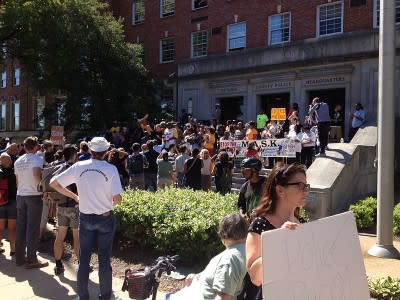More journalist arrests in Ferguson add to First Amendment media debate
After more violence in Ferguson, Missouri, reports of more journalist arrests have sparked debate about the media’s First Amendment right to report the news without obstructing police activities.
Wikicommons user: Lovesofbread
Earlier today, Constitution Daily broke down the constitutional arguments over the limited First Amendment rights of citizens and journalists to videotape and record police officers who are performing their duties.
Link: Ferguson and The Videotaping Debate
In short, some courts have recognized the First Amendment right of citizens, including journalists, to videotape police in public places where they have a right to be present. But it is not an unlimited right and it is subject to reasonable time, place, and manner restrictions in order to protect public safety.
Our analysis focused on the arrest and later release last week of reporters from the Washington Post and Huffington Post who were detained inside a McDonald’s restaurant.
But according to reports, as many as 14 American and foreign journalists have been arrested by law enforcement officers since the protests began over the fatal shooting of an unarmed black teenager by a police officer.
On Tuesday, journalist Ryan Devereaux from the website The Intercept detailed his night in jail in a blog post. The Intercept was co-founded by Glenn Greenwald as a platform to report on information leaked to the media by whistleblower Edward Snowden.
Devereaux said he and Lukas Hermsmeier, a German reporter for Bild, were caught in between protesters and police, and they both identified themselves as journalists. Devereaux said the two journalists were shot with what he thought were rubber bullets and then arrested, without a reading of their Miranda rights. A third journalist saw the incident and notified Devereaux’s editor, who was able to get the men released from jail.
On Tuesday, Missouri Highway Patrol Capt. Ron Johnson spoke about the various incidents on Monday night in Ferguson to a room full of reporters.
First, Johnson explained that new rules requiring protesters to continuously walk in protest areas wasn’t a violation of the First Amendment right to assemble.
“We’re not violating your rights, we’re allowing you to protest,” Johnson said. “Protesting does not need to stand still, it needs to be heard. It needs to move forward,” he added. “So really, the marching around in the circles, we’re keeping our voice moving. I don’t want it to stand still.”
Johnson also indicated confusion during the protests over which people in crowds are accredited journalists and which aren’t.
“So yes, we may take some of you into custody,” Johnson told the reporters. “But when we do take you into custody, and we have found out that you are a journalist, we have taken the proper action.”
The list of journalists arrested and then released by police so far includes representatives from Getty Images, Sports Illustrated, The (London) Telegraph, the Financial Times and a St. Louis alderman who was videotaping the protests.
Part of the issue, acknowledged by the Washington Post, is that hundreds of journalists have swarmed into Ferguson trying to get close to the protests.
The Post said that, by one estimate, there were as many reporters covering one protest as the actual number of protesters assembled in the street.
But other video from Ferguson shows journalists identifying themselves as media to police before they are arrested and then released.
The journalism organization The Poynter Institute showed video and Twitter messages documenting their arrests, which were ordered by Johnson.
Getty Images photographer Scott Olson also was arrested by police and video of his detention was shown on Instagram and then national television. During his arrest, Olson can be heard saying, “I’m being arrested because they said the media is required to be in a certain area.”
Frank Herrmann, an America-based reporter for a German media outlet, said he and a fellow journalist were arrested as they stood with a group of police officers, with no one else around.
“The bizarre thing about the situation was after he grabbed my colleague and me, we were the only people in the vicinity except half a dozen policemen,” Hermann told a TV station in a phone interview. “I am angry at the local police in Ferguson. I did my job.”
In the long run, the incidents in Ferguson involving police and journalists highlight the difficulty of protecting First Amendment rights in a fluid situation.
Poynter’s Ellyn Angelotti wrote about this tension last week in a blog post that reminded reporters about their rights, and the rights of law enforcement, in the Ferguson situation.
“The police can regulate the time, place and manner of speech to a certain degree as long as it is not a content-based regulation. Meaning, they can clear an area of everyone if they think they need to do that to keep the peace, but they can’t single out a journalist and tell him he cannot be there,” she said.
“A journalist has the same rights as the general public to access public property. And, generally, it is legal to record video of people where they would reasonably expect to be seen. However, journalists are not granted special rights to disobey police orders, nor are they allowed to interfere with police work.”
Scott Bomboy is the editor in chief of the National Constitution Center.
Recent Stories on Constitution Daily
The debate over Ferguson and videotaping police
10 fun facts about the 42nd president, Bill Clinton
Constitution Check: Should criminal charges be used to settle a political dispute?



